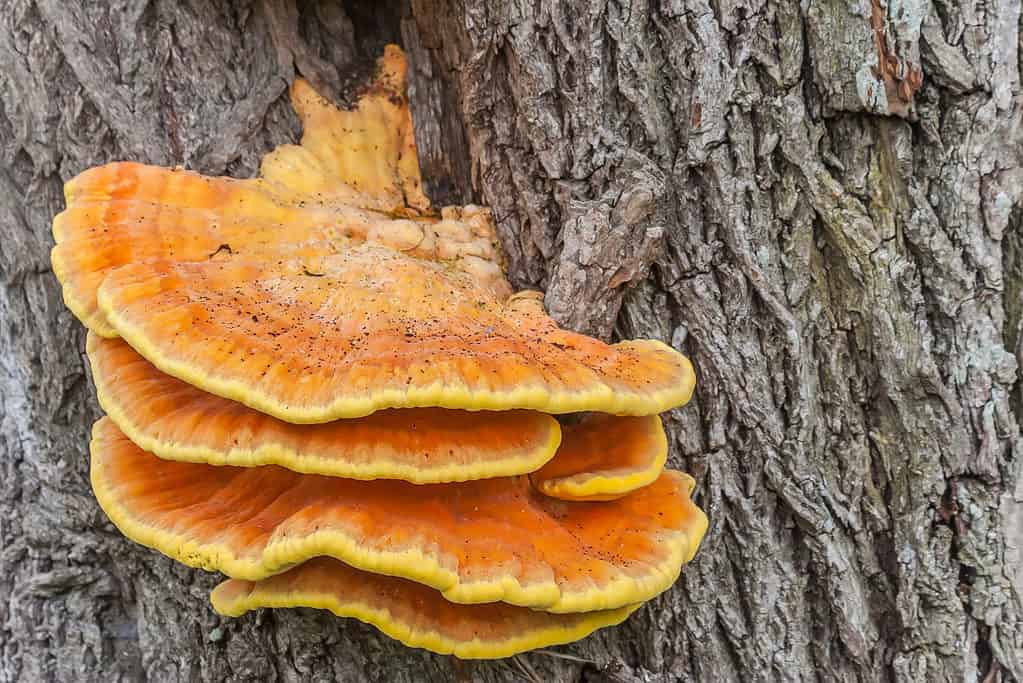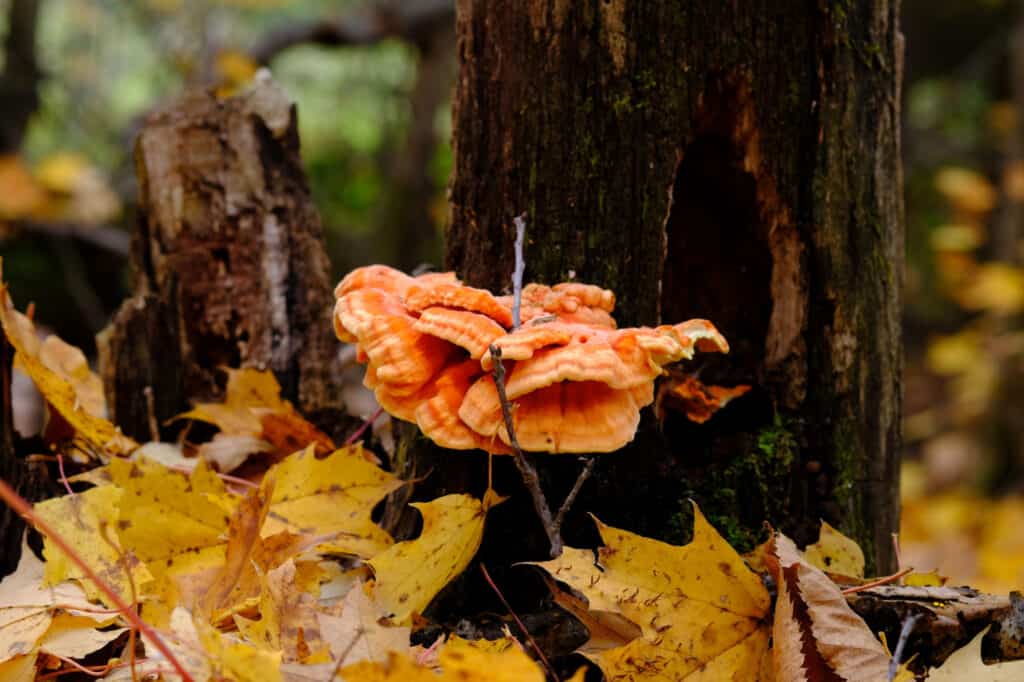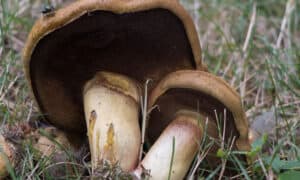Have you ever heard of chicken of the woods mushrooms? This mushroom shouldn’t be confused with hen of the woods, which is another type of edible mushroom. The chicken of the woods is a unique edible mushroom with a bright, orange to gold-yellow hue and deliciously meat-like texture that gave it its name.
Do you want to start harvesting chicken of the woods mushrooms? If so, you’re in luck. If you live in North America or Europe, finding these mushrooms aren’t too hard. There are many species of chicken of the woods that have a pretty varied distribution. In the eastern U.S., two of the more common species are Laetiporus sulphreus and Laetiporus cincinnatus. Laetiporus huroniensis and Laetiporus gilbertsonii var. pallidus can be found in that area as well. The more common species you’ll find on the West Coast are Laetiporus gilbertsonii, Laetiporus sulphureus, and Laetiporus conifericola.
Just keep in mind that it’s vital to know everything about a mushroom before foraging and eating it. In this guide, we’ll explore everything you need to know about the chicken of the woods mushroom, from its defining features to its lookalikes to where it grows.
Information About Chicken of the Woods Mushrooms
| Chicken of the Woods Mushrooms | |
|---|---|
| Classification | Laetiporus genus, except Laetiporus persicinus |
| Description | An edible yellow-orange or white mushroom known for its chewy meaty texture and flavor that is similar to very mild chicken, which is its namesake. |
| Uses | Culinary (when cooked thoroughly) |
| How to Grow | Due to the fact that this mushroom is slightly parasitic to the tree it is attached to, it must be grown specifically on logs. |
| How to Forage | This brightly-colored mushroom is easy to spot growing on stumps and logs. Keep an eye out for these mushrooms are spring, summer, and early fall. |
| Key Identifying Features | Look for fan-shaped, somewhat bright yellow-orange mushrooms growing in clusters. These mushrooms also have a texture similar to suede. |
| Origin | North America, Europe, and possibly elsewhere |
Chicken of the Woods Mushrooms: Classification
The chicken of the woods mushroom is classified as a number of different species in the Laetiporus genus. Laetiporus sulphureus is specifically known as the sulfur polypore or the sulfur shelf mushroom. As a member of the Laetiporus genus, chicken of the woods mushrooms are closely related to similar mushrooms such as Laetiporus portentosus and Laetiporus baudonii, among others.

Chicken of the woods mushrooms (pictured) are parasitic and grow on the sides of dead and living trees.
©Marc Venema/Shutterstock.com
Chicken of the Woods Mushrooms: Key Identifying Features and Appearance
The chicken of the woods mushroom is considered a bracket fungus, or a type of fungus that grows on the sides of wood rather than in the dirt.
A polypore fungus, chicken of the woods has tiny holes on its bottom instead of teeth or gills. It grows on dead trees, fallen logs, and stumps because it consumes and aids in the decomposition of dead tree wood. It can occasionally be seen on a living tree when it parasitizes the tree and causes the wood to decay.
The first thing to look for when recognizing chicken of the woods is the type of tree it is growing on. They are often seen on oaks. However, different species grow on different trees. Laetiporus huroniensis and Laetiporus conifericola, for example, grow on conifer trees.
The top surface of the chicken of the woods mushroom is smooth or slightly wrinkled and varies in color from orange-red to orange-yellow. Typically, the borders are wavy and brilliant yellow. Some species, like Laetiporus cincinnatus, have a white margin and bottom. The overlapping clusters of the semi-circular to fan-shaped caps, which range in size from two to twelve inches wide, can produce quite huge fruiting bodies.
There is no stem on the chicken of the woods. There might be a pseudostem, which is essentially a portion of the caps. Since it can be tough and chewy, you don’t often cook this portion of the mushroom. The bottom of this mushroom is often a vivid sulfurous yellow and has very small pores, though different colors can be seen on different species. The color of the spores is white, but since they occasionally discharge them immediately after cutting, it might be challenging to get a spore print.
Chicken of the Woods Mushrooms: Where They Grow
Chicken of the woods is a sulfur-yellow bracket fungus that grows on trees in forests, parks, and gardens. It favors oak but also enjoys beech, chestnut, cherry, yew, and many others as well. It is frequently seen in tier-like clusters on oak.
In North America and Europe, chicken of the woods is a mushroom that grows on standing or felled wood, usually on the rotting or dead trunks of oak trees. This polypore can develop on fallen tree trunks and, less commonly, on big detached branches, but it is typically found on the standing trunks of trees.
Chicken of the woods mushrooms are somewhat common around the British Isles, seldom in many areas of Britain and Ireland, and occasionally a major problem in Yew woodlands. Additionally, regions of the United States and Europe are home to this or closely related species. Laetiporus sulphureus, for example, is a species of chicken of the woods that can be found around California.
In the wood of standing and dead oaks and other hardwoods, the chicken of the woods fungus produces a brown heart rot. It grows most commonly in the hardwood forests of North America.
Chicken of the Woods Mushrooms: Toxic Lookalikes
Piptoporellus species like Piptoporellus soloniensis look very similar to chicken of the woods mushrooms and are common lookalikes.
Novice mushroom foragers and hobbyists may also be misled by the jack-o-lantern mushroom, also known as Omphalotus illudens. This mushroom has extremely noticeable gills on the bottom and grows on rotting wood. It won’t have an underside with a smooth pored surface. Additionally, it can sometimes be bioluminescent, meaning it glows in the absence of light. You shouldn’t consume jack-o-lantern mushrooms since doing so can cause intense intestinal pain and upset, but you can safely pick one up to examine it or take it home to see whether it glows in the dark.
Another possible look-alike would be the chanterelle mushroom. Except for the fact that they are both orange in color, this fungus does not resemble the chicken of the woods very much. This fungus is a prized edible kind, so even if you accidentally harvest it, it is not dangerous and would still be a nice discovery. The fact that the chanterelle mushroom has ridges on the bottom sets it apart most significantly from the chicken of the woods mushroom. However, some chanterelles are smooth, such as Cantharellus lateritus. The chanterelle also frequently grows closely around trees and emerges from the ground, as opposed to the chicken of the woods mushroom, which usually grows directly from the tree.
Chicken of the Woods Mushrooms: How They Are Used
The majority of uses for chicken of the woods mushrooms are culinary. It has the same texture as chicken, and is quite firm, and some people claim that it tastes like chicken. It works well in stews as a vegetarian “meat.” Best consumed while young since older specimens develop a woody and bitter flavor. It has to be cooked thoroughly before eating. The best cooking methods for chicken of the woods mushrooms are frying, baking, sautéing, and blanching. However, blanching should be done in addition to another cooking method to ensure it is thoroughly cooked. They may be used interchangeably in dishes as a meat alternative to chicken or tofu.
Chicken of the Woods Mushrooms: Where They Are Purchased
Chicken of the woods is not a very common mushroom to find in your local grocery store. However, they can be found in some specialty stores or at farmer’s markets. Chicken of the woods can cost around $20 per pound in the United States, though this price can vary significantly. It is often sold dried or fresh.
Your best bet to find some chicken of the woods mushrooms to eat is to forage for them yourself. Chicken of the woods grows on or near dead or dying hardwood trees, most frequently on oak, although it can also grow on cherry or beech. Additionally, dead conifer stumps may have it. It has also been reported that chicken of the woods produces fruit on live trees.
The Chicken of the Woods Mushroom Life Cycle and Behavior
The species Laetiporus sulphureus, also known as the sulfur polypore or the chicken of the woods, is a bracket fungus that is easily identified by its characteristic sulfur-yellow hue. On the trunks of mature trees, like oaks, it develops around the trunk. Instead of using sunlight as plants do, fungi receive their nutrition and energy from organic materials. We frequently only see the fruiting bodies, also known as mushrooms, which are made up of a web of microscopic filaments called hyphae. These fruiting bodies generate spores for reproduction.
How to Grow Chicken of the Woods Mushrooms
Chicken of the woods mushrooms are pretty tricky to grow but can possibly be grown through the use of tree stumps.
Pre-Treat Your Log
On the oak family of hardwood trees, chicken of the woods grows. For the purpose of raising chicken in the woods mushrooms, start by cutting healthy, live trees. Working with diseased trees or old, fallen logs is not recommended. To prepare the logs for treatment in the following step, cut them into pieces that will fit into the autoclavable bags. The typical dimensions of a log should be around 11 inches tall.
Each log portion should be placed inside an autoclavable bag. Log segment treatment can be done in one of three ways. You can soak your logs for up to an hour before treatment if they appear to be dry.
Treat with a Pressure Cooker
Put the bagged log into your pressure cooker. Except where the log sits on the canner rack, keep all plastic away from the canner surfaces. A 120-minute cook at 15 psi normally requires several inches of water, so add around that much. Allow the log to cool after treatment.
Start Inoculation
The logs can be inoculated once they have cooled. The logs can wait to be inoculated in a clean environment if they are bagged when they are treated. To lessen the chance of infection during inoculation, thoroughly sterilize the inoculation location and spawn bag and restrict air movement. By kneading the bag, disassemble the sawdust spawn. Remove the collar and foam plug from each bagged log, then cut or rip open the spawn bag. After that, add one cup of spawn to each bag of spawned logs. Replace the collar and foam plug as soon as possible, then move the spawn around to cover the top and bottom of the log.
Wait for Mushrooms to Grow
Place the log in a room with a constant temperature for two to three months of incubation. As the wood becomes colonized, the mycelium will spread out throughout its surface, forming a white layer that will gradually become yellow and finally orange. The log should eventually be mostly mycelium-covered and prepared for burial outside. Green mold pollutants may also appear, but they are only an annoyance and shouldn’t have an impact on the local chicken population.
How cool is the Chicken of the Woods mushroom? When foraging for these tasty delicacies, make sure to be mindful of potential lookalikes. Once you’re a bit more experienced at foraging, spotting these edible mushrooms will be easy. Alternatively, you can follow the instructions above to start growing your own!
How Do You Clean Chicken of the Woods?

These fungi may soak up water and can lose flavor so you should avoid rinsing them too much
©nomis_h/Shutterstock.com
Chicken of the woods is considered one of the easiest mushrooms to find and is also thought of as a beginner-friendly fungi. With its meaty taste, it can be used quite often as a replacer for other items like chicken. But how do you clean it? Once you have foraged this delicious mushroom, you should make sure you trim away any pieces that bugs have made a snack of.
Like many mushrooms, you should then clean away any dirt with either a damp towel or cloth, or use a mushroom brush. These fungi may soak up water and can lose flavor so you should avoid rinsing them too much, but if there is still dirt present, a quick rinse should work, followed by a gentle pat to dry. They can last fresh for about one week and unlike other, gentler mushrooms, you can keep them longer by storing them in the freezer.
The photo featured at the top of this post is © nomis_h/Shutterstock.com
The information presented on or through the Website is made available solely for general informational purposes. We do not warrant the accuracy, completeness, or usefulness of this information. Any reliance you place on such information is strictly at your own risk. We disclaim all liability and responsibility arising from any reliance placed on such materials by you or any other visitor to the Website, or by anyone who may be informed of any of its contents. None of the statements or claims on the Website should be taken as medical advice, health advice, or as confirmation that a plant, fungus, or other item is safe for consumption or will provide any health benefits. Anyone considering the health benefits of particular plant, fungus, or other item should first consult with a doctor or other medical professional. The statements made within this Website have not been evaluated by the Food and Drug Administration. These statements are not intended to diagnose, treat, cure or prevent any disease.
Sources
- Michael Kuo, Available here: https://www.mushroomexpert.com/laetiporus_sulphureus.html
- Pat O'Reilly, Available here: https://www.first-nature.com/fungi/laetiporus-sulphureus.php
- Gary Emberger, Available here: https://www.messiah.edu/Oakes/fungi_on_wood/poroid%20fungi/species%20pages/Laetiporus%20sulphureus.htm
FAQs (Frequently Asked Questions)
Are chicken of the woods mushrooms edible?
Yes. And they also taste a bit like chicken, hence their name.
Do chicken of the woods mushrooms have a poisonous counterpart?
Fortunately, chicken of the woods mushrooms are fairly unique-looking and poisonous mushrooms are rarely mistaken for them. One exception could be the jack-o-lantern mushroom or omphalotus olearius, which has a similar color.
Do I need to cook chicken of the woods mushrooms?
Since these mushrooms are usually wild-foraged, it is always best to clean and cook your chicken of the woods mushrooms before eating them.
Thank you for reading! Have some feedback for us? Contact the AZ Animals editorial team.






